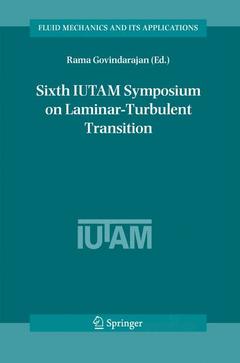INVITED lectures: Laminar separation bubbles, by M. Gaster; Transient growth with application to bypass transition, by Dan Henningson;The role of external disturbances in laminar-turbulent transition, by Xuesong Wu; Modeling the effects of two-dimensional steps on boundary-layer transition, by Jeffrey D Crouch, V.S. Kosorygin, L.L. Ng; Recent observations in the transition to turbulence in a pipe, by Tom Mullin, J. Peixinho; Localised instability in unsteady separation bubbles, by Jaywant H. Arakeri, S.P. Das, Usha Srinivasan; Interaction of separation and transition in boundary layers: Direct Numerical Simulations, by Herman F. Fasel, Dieter Postl; INSTABILITY I: On fundamental instability mechanisms of nominally two-dimensional separation bubbles, by M. Simens, L. Gonzalez, V. Theofilis, R. Gomez-Blanco; A new stability approach for the flow induced by wall injection, by G. Casalis, F. Chedevergne, Th. Feraille, G. Avalon; INSTABILITY II: The pecularities of development of forerunners on longitudinal structures fronts in the boundary layer of a straight wing, by V.N. Gorev, M.M. Katasonov, V.V. Kozlov; Observation of nonlinear travelling waves in turbulent pipe flow, by B. Hof, Casimir W.H.van Doorne, J. Westerweel, Frans T.M. Nieuwstadt; INSTABILITY III: A strange instability with growth normal to a boundary layer, by J. J. Healey; Numerical studies of streak instability in boundary layers, by Luca Brandt, Carlo Cossu, Dan S. Henningson, J.M. Chomaz, P. Huerre; A possible linear instability mechanism in small-scale pipe flows, by Kirti Chandra Sahu; Effects of strong adverse pressure gradients and incident wakes on transition and calming, by J.P. Gostelow, R.L. Thomas; INSTABILITY IV: Effect of free-stream turbulence on a compressible laminar boundary layer, by Pierre Ricco, Xuesong Wu; Effect of viscosity stratification on secondary and nonmodal instabilities, by A. Sameen; Spectral element stability analysis of vortical flows, by Michael S. Broadhurst, V. Theofilis, S.J. Sherwin; INSTABILITY V: Experimental study of resonant interactions of instability waves in an airfoil boundary layer, by D. Sartorius, W. Wurz, T. Ries, M. Kloker, S. Wagner, V.I. Borodulin, Y.S. Kachanov; Klebanoff modes in swept boundary layers, by Karen Kudar, P.W. Carpenter, Christopher Davies; Effects of compressibility and nose radius on instabilities near the attachment line of swept wings, by J. Sesterhenn, R. Friedrich; INSTABILITY VI: Two-dimensional local instability: complete Eigen value spectrum, by Jean-Christophe Robinet, Chloe Pfauwadel; Instability of flow past a cascade of circular cylinders, by Jitesh S.B. Gajjar; A wave driver theory for vortical waves propagating across junctions between rigid and compliant walls, by P.K. Sen, P.W. Carpenter, S. Hegde, C. Davies; FLOW CONTROL I: Optimal suction design for hybrid laminar flow control, by Jan O. Pralits, Ardeshir Hanifi; Transition control in a flat-plate boundary layer, by Seichiiro Izawa, Takeshi Sakai, Ayumu Inasawa, Ao-kui Xiong, Yu Fukunishi; Linear feedback control of transition in shear flows, by Jerome Hoepffner, M. Chevalier, T. Bewley, Dan S. Henningson; Effects of ambient viscosity on the entrainment and dynamics of a buoyant jet, by Manikandan Mathur, K.R. Sreenivas; FLOW CONTROL II: Disturbance development in boundary layers over compliant surfaces, by Christopher Davies, P.W. Carpenter, Reza Ali, D.A. Lockerby; Suppression of wall turbulence based on stability and turbulence analysis using compliant surfaces, by P.K. Sen, P.S. Josan, S.V. Veeravalli; Roughness induced transient growth: nonlinear effects, by Meelan Choudhari, Paul Fischer; Feedback control in spatially growing boundary layers, by Mattias Chevalier, J. Hoepffner, E. Akervik, D.S. Henningson; FLOW CONTROL III: Effect of elastic supports on the critical value of Reynolds number past a cylinder, by Sanjay Mittal, Saurav Singh; Improvement of lift-to-drag ratio of the aero-train, by Yasuaki P. Kohama, Dong-h




